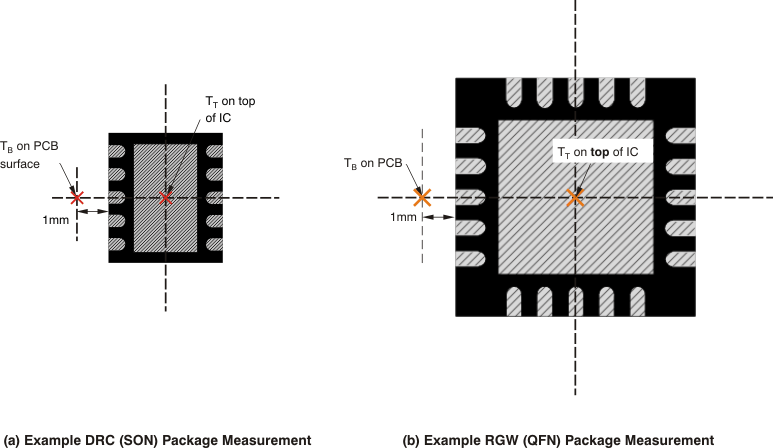ZHCSN49N January 2007 – June 2024
PRODUCTION DATA
- 1
- 1 特性
- 2 应用
- 3 说明
- 4 Pin Configuration and Functions
- 5 Specifications
- 6 Detailed Description
- 7 Application and Implementation
- 8 Device and Documentation Support
- 9 Revision History
- 10Mechanical, Packaging, and Orderable Information
封装选项
机械数据 (封装 | 引脚)
散热焊盘机械数据 (封装 | 引脚)
订购信息
7.4.1.1 Estimating Junction Temperature
Using the thermal metrics ΨJT and ΨJB, as shown in the Thermal Information table, the junction temperature can be estimated with corresponding formulas (given in Equation 8). For backwards compatibility, an older θJC,Top parameter is listed as well.

Where PD is the power dissipation shown by Equation 6, TT is the temperature at the center-top of the device package, and TB is the PCB temperature measured 1 mm away from the device package on the PCB surface (Figure 7-14).
For more information about measuring TT and TB, see the Using New Thermal Metrics application note, available for download at www.ti.com.
 Figure 7-14 Measuring Points for TT and TB
Figure 7-14 Measuring Points for TT and TBBy looking at Figure 7-15, the new thermal metrics (ΨJT and ΨJB) have very little dependency on board size. That is, using ΨJT or ΨJB with Equation 8 is a good way to estimate TJ by simply measuring TT or TB, regardless of the application board size.
 Figure 7-15 ΨJT and ΨJB vs Board Size
Figure 7-15 ΨJT and ΨJB vs Board SizeFor a more detailed discussion of why TI does not recommend using θJC(top) to determine thermal characteristics, see the Using New Thermal Metrics application note, available for download at www.ti.com. For further information, see the IC Package Thermal Metrics application note, also available on the TI website.